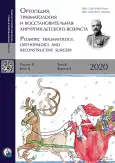Retroclival hematoma: two case reports and a literature review
- Authors: Khodorovskaya A.M.1,2, Kondrashev I.A1, Mandal V.1, Lyapin A.P.1
-
Affiliations:
- N.F. Filatov Children City Clinical Hospital No. 5
- H. Turner National Medical Research Center for Сhildren’s Orthopedics and Trauma Surgery
- Issue: Vol 8, No 4 (2020)
- Pages: 467-472
- Section: Clinical cases
- Submitted: 26.04.2020
- Accepted: 21.09.2020
- Published: 09.01.2021
- URL: https://journals.eco-vector.com/turner/article/view/33920
- DOI: https://doi.org/10.17816/PTORS33920
- ID: 33920
Cite item
Abstract
Background. Тraumatic hematomas in the posterior fossa rarely occur, which account for 0.01%–0.6% of brain injury cases. Retroclival location for such hematomas is uncommon, as they are mostly epidural and diagnosed almost exclusively in the pediatric population.
Clinical cases. Herein, we report two pediatric cases of traumatic epidural and traumatic subdural retroclival hematomas that developed after high-energy trauma in motor-vehicle accidents.
Discussion. Related studies were reviewed, and anatomical features and neuroimaging findings associated with various compartments of the retroclival hemorrhage in children were discussed.
Conclusion. Considering the nonspecific clinical features and special topographic correlation of anatomical structures in this region, neuroimaging is regarded as the most reliable method to diagnose and correctly classify this pathology, which is essential for further treatment.
Full Text
About the authors
Alina M. Khodorovskaya
N.F. Filatov Children City Clinical Hospital No. 5; H. Turner National Medical Research Center for Сhildren’s Orthopedics and Trauma Surgery
Author for correspondence.
Email: alinamyh@gmail.com
ORCID iD: 0000-0002-2772-6747
SPIN-code: 3348-8038
neurosurgeon, Outpatients Department; MD, Scientific Associate of Physiology and Biomechanics Research Laboratory
Russian Federation, Saint-PetersburgIgor A Kondrashev
N.F. Filatov Children City Clinical Hospital No. 5
Email: kigan777@gmail.com
ORCID iD: 0000-0002-3086-4358
MD, PhD, Honored Doctor of the Russian Federation, Head of the Department of Diagnostic Imaging
Russian Federation, Saint PetersburgVaishali Mandal
N.F. Filatov Children City Clinical Hospital No. 5
Email: bitctmri2001@mail.ru
ORCID iD: 0000-0002-9211-1378
MD, PhD, Radiologist, Department of Diagnostic Imaging
Russian Federation, Saint PetersburgAndrey P. Lyapin
N.F. Filatov Children City Clinical Hospital No. 5
Email: aplapin@mail.ru
MD, Head of the Department of Neurosurgery
Russian Federation, Saint PetersburgReferences
- Крылов В.В., Талыпов А.Э., Ткачев В.В. Повреждения задней черепной ямки. – М.: Медицина, 2005. [Krylov VV, Talypov AE, Tkachev VV. Povrezhdeniya zadney cherepnoy yamki. Moscow: Meditsina; 2005. (In Russ.)]
- Casey D, Chaudhary BR, Leach PA, et al. Traumatic clival subdural hematoma in an adult. J Neurosurg. 2009;110(6):1238-1241. https://doi.org/10.3171/ 2008.9.JNS17651.
- Ahn ES, Smith ER. Acute clival and spinal subdural hematoma with spontaneous resolution: Clinical and radiographic correlation in support of a proposed pathophysiological mechanism. Case report. J Neurosurg. 2005;103(2 Suppl):175-179. https://doi.org/10.3171/ped.2005.103.2.0175.
- Anik I, Ceylan S, Koc K, et al. Microsurgical and endoscopic anatomy of Liliequist’s membrane and the prepontine membranes: Cadaveric study and clinical implications. Acta Neurochir (Wien). 2011;153(8):1701-1711. https://doi.org/10.1007/s00701-011-0978-5.
- Coleman CC, Thompson JL. Extradural hemorrhage in the posterior fossa. Surgery. 1941;10(6):985-990. https://doi.org/10.5555/uri:pii:S003960604190243X.
- Agrawal D, Cochrane DD. Traumatic retroclival epidural hematoma — a pediatric entity? Childs Nerv Syst. 2006;22(7):670-673. https://doi.org/10.1007/s00381-006-0059-x.
- Haines DE, Harkey HL, al-Mefty O. The “subdural” space: A new look at an outdated concept. Neurosurgery. 1993;32(1):111-120. https://doi.org/10.1227/00006123-199301000-00017.
- Guillaume D, Menezes AH. Retroclival hematoma in the pediatric population. Report of two cases and review of the literature. J Neurosurg. 2006;105(4 Suppl):321-325. https://doi.org/10.3171/ped.2006.105.4.321.
- Paterakis KN, Karantanas AH, Hadjigeorgiou GM, et al. Retroclival epidural hematoma secondary to a longitudinal clivus fracture. Clin Neurol Neurosurg. 2005;108(1): 67-72. https://doi.org/10.1016/j.clineuro.2004.11.010.
- Kurosu A, Amano K, Kubo O, et al. Clivus epidural hematoma. Case report. J Neurosurg. 1990;72(4):660-662. https://doi.org/10.3171/jns.1990.72.4.0660.
- Samanci Y, Baskurt I, Celik SE. Traumatic retroclival epidural hematoma. Pediatr Emerg Care. 2019;35(10):e184-e187. https://doi.org/10.1097/PEC.0000000000001756.
- Koshy J, Scheurkogel MM, Clough L, et al. Neuroimaging findings of retroclival hemorrhage in children: A diagnostic conundrum. Childs Nerv Syst. 2014;30(5):835-839. https://doi.org/10.1007/s00381-014-2369-8.
- Silvera VM, Danehy AR, Newton AW, et al. Retroclival collections associated with abusive head trauma in children. Pediatr Radiol. 2014;44 Suppl 4:S621-631. https://doi.org/10.1007/s00247-014-3170-2.
- Ratilal B, Castanho P, Vara Luiz C, Antunes JO. Traumatic clivus epidural hematoma: Case report and review of the literature. Surg Neurol. 2006;66(2):200-202. https://doi.org/10.1016/j.surneu.2005.11.030.
- Yama N, Kano H, Nara S, et al. The value of multidetector row computed tomography in the diagnosis of traumatic clivus epidural hematoma in children: A three-year experience. J Trauma. 2007;62(4):898-901. https://doi.org/10.1097/01.ta.0000221058.72995.c9.
- Kwon TH, Joy H, Park YK, Chung HS. Traumatic retroclival epidural hematoma in a child: Case report. Neurol Med Chir (Tokyo). 2008;48(8):347-350. https://doi.org/10.2176/nmc.48.347.
- Nguyen HS, Shabani S, Lew S. Isolated traumatic retroclival hematoma: Case report and review of literature. Childs Nerv Syst. 2016;32(9):1749-1755. https://doi.org/10.1007/s00381-016-3098-y.
- Tubbs RS, Griessenauer CJ, Hankinson T, et al. Retroclival epidural hematomas: A clinical series. Neurosurgery. 2010;67(2):404-406. https://doi.org/10.1227/01.NEU.0000372085.70895.E7.
- Meoded A, Singhi S, Poretti A, et al. Tectorial membrane injury: Frequently overlooked in pediatric traumatic head injury. AJNR Am J Neuroradiol. 2011;32(10):1806-1811. https://doi.org/10.3174/ajnr.A2606.
- Papadopoulos SM, Dickman CA, Sonntag VK, et al. Traumatic atlantooccipital dislocation with survival. Neurosurgery. 1991;28(4):574-579. https://doi.org/10.1097/00006123-199104000-00015.
- Marks SM, Paramaraswaren RN, Johnston RA. Transoral evacuation of a clivus extradural haematoma with good recovery: A case report. Br J Neurosurg. 1997;11(3):245-247. https://doi.org/10.1080/02688699746339.
- Yang BP. Traumatic retroclival epidural hematoma in a child. Pediatr Neurosurg. 2003;39(6):339-340. https://doi.org/10.1159/000075264.
- Desimpel J, Parizel PM, Dekeyzer S. Posttraumatic retroclival hematoma: A case report. Acta Neurol Belg. 2020;120(1):177-178. https://doi.org/10.1007/s13760-019-01117-3.
- Zabalo G, Ortega R, Diaz J, et al. Retroclival epidural haematoma: A diagnosis to suspect. Report of three cases and review of the literature. Acta Neurochir (Wien). 2017;159(8):1571-1576. https://doi.org/10.1007/s00701-017-3214-0.
Supplementary files












